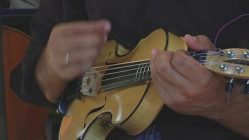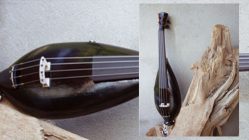How did you come up with the idea for the Electrolin?
The Electrolin electric violin was born out of the necessity felt by Aurélien from the very beginning of his experimentation with an electrified viola: to keep a true acoustic instrument sound while eliminating the problems associated with feedback. After experimenting with electromagnetic pickups without success, and using the “Neola” built in 2013 by Bodo which was satisfactory in terms of sound but not for feedback resistance, Aurélien, then a student in the merchant navy, had an illumination one day in 2016 while studying physics and materials properties related to ships, and came up with the idea of creating a surface made of too small sound receptors to capture anything in the audio range.
How does it work?
The basic principle behind the Electrolin is an old story in acoustics. To simplify it: a sound emitter that is smaller than the wavelength it is supposed to emit produces little or no sound. Similarly, a receiver that is too small can only pick up very high frequencies. Aurélien then had the idea of creating a surface made of too small sound receptors to capture anything in the audio range. This surface (a perforated sheet metal) becomes the body of our violins and hardly perceives the sound coming from the speakers, nor does it emit much sound. This prevents the body from generating feedback, despite the presence of contact sensors on its surface. An aluminum violin resonator with vaults, f-holes, soundpost and bass bar, having slightly different vibrational properties from wood, which is excited in the same way as a wooden violin, that is, by strings rubbed by a bow, will vibrate in a very similar way to that of a wooden resonator. It vibrates, but it does not emit sound. In the same way, it is not excited by the sound waves coming back from the speakers. Its “mechanical” vibrational modes, however, can be electrically captured and amplified to transform them back into sound.
On the web, we come across videos of the “Zef” which seems very similar to the Electrolin. Is it the same thing?
The Zef is the predecessor of the Electrolin. For various reasons more or less related to the sanitary crisis of 2020-2022, the marketing of the Zef did not have the deserved success. Since the name Zef was registered by the co-designer and collaborator in the manufacture of the Zef, Aurélien Bertrand, the name Zef left the project with its owner.
The Electrolin is the continuation and culmination of the development of the Zef, to which it owes (almost) everything.
Moreover, until their future replacement, you will continue to find on this site videos and photos talking about the Zef. Everything said there applies to the Electrolin to a very large extent, except for what concerns the preamp, which was abandoned along the way.
Why is the Electrolin made of aluminum?
Wood, perforated in a similar way, would become very brittle. Carbon fiber, which would theoretically be well suited for this purpose, is very difficult to perforate. Glass and cheese as raw materials were automatically discarded.
Is the Electrolin made in France?
Yes, the Electrolin is entirely made in France by Bodo and a CFAO specialist friend (Computer-Aided Design and Manufacture), who wishes to remain anonymous. It is the result of the mastery of lutherie, including small artisanal series, by the former, and the mastery of computer tools and machining by the latter. The aluminum sheets, on the other hand, come from nuclear and biological metallurgy. “No, let’s not talk nonsense, aluminum production is an environmental mess (one more 🙁). But we recycle our aluminum scraps!
Why is Electrolin better than ordinary electric violins?
Electric violins, as we know them for about forty years, completely omit the resonance box to avoid any Larsen phenomenon, replacing this box with a solid beam made of various materials. This often makes them heavy. They capture only the vibration of the strings, thus amputating the sound of all the complexity and warmth brought by the resonance box. High-end models try to restore this harmonic complexity, but cannot entirely lose the “MIDI” sound that develops from the signal of a bowed string, and does not replace the short natural reverb brought by a real resonance box.
What is a Larsen?
Larsen is the worst enemy of amplified musicians. It is created on certain notorious frequencies by the sound returning from the instrument through the speakers. The sound waves from the speakers then vibrate the instrument on its own frequency, amplifying it. The machine goes into overdrive, and the instrument-speaker duo remains stuck on this very loud and unpleasant frequency. Some electric guitarists deliberately seek this effect by standing in front of the speakers. Unfortunately, the Larsen effect with an electro-acoustic instrument is not controllable in the same way. With an amplified acoustic instrument, Larsen is triggered either from a certain sound level or very quickly and almost inevitably with certain electronic effects. It also depends on the distance between the musician and the speaker.
Does Electrolin need a preamp?
No, it doesn’t. However, it can be useful for pre-setting, especially for volume, and for entering an amplifier or mixing console with an increased level.
Does Electrolin need a power supply?
No, Electrolin itself does not require batteries or any other connection than the amplifier.
Can I play Electrolin without amplification?
Due to having a real but “silent” resonance box, Electrolin makes an excellent study instrument. The emitted sound level is low enough not to disturb neighbors or children, day or night, but loud enough to be heard, including nuances. Due to the vibrating box, you have the true “feeling” of the violin. And of course, you can also play it with headphones! As with all other electric violins, you can work with headphones and not disturb parents, children, or neighbors… But with Electrolin, you’re not just working on intonation; the playing intentions are fully transmitted by the instrument.
Does Electrolin support all electronic effects?
Yes, Electrolin supports absolutely all electronic effects. Only the wah-wah + saturation combination can lead to Larsens at very high levels. But this is also true for solid-body instruments, i.e., without a resonance box. It is then advisable to use a gate, which will also eliminate the instrument manipulation noises when saturation is switched on, which is a common practice with solid-body instruments.
Can I play Electrolin without cables?
Of course, Electrolin is compatible with wireless systems. We would be happy to find the best place to place the transmitter on the instrument box with you.
Do the sensors look fragile? Will they last over time?
If you take care of them (as you should with a musical instrument), the sensors still do their job perfectly four years later. If they need to be changed, it is inexpensive, and we can perform the operation. To do this, you can either come to see us in Toulouse, or we can send your Electrolin by Colissimo.
What strings do you recommend for Electrolin?
Strings have a real impact on the sound of Electrolin, just as they do on the sound of an acoustic violin. You can customize the sound of your Electrolin with the string set of your choice.
Is it possible to adjust the sound of the Electrolin?
Since the Electrolin has a soul and a real luthier bridge (rather than a rough vertical board like many electric violins), an authorized luthier can make sound adjustments as if it were an acoustic violin.
What kind of sensors do you use? Not some cheap piezo, right?
Well, yes. We use piezo sensors. The reason why the sound is so good at the output is that these sensors are located on the top and bottom of the instrument, and we use PVDF sensors. This material, a cousin of PVC, comes in the form of a film. Unlike ceramic piezo sensors, they have an absolutely flat frequency response in the audio range. So, there are no nasal frequencies. Moreover, this film is now commonly used in microphones and phone speakers. Have you noticed that the sound of phones has improved in recent years? Well, that’s thanks to PVDF.
Can the Electrolin be customized?
Our basic version is already customizable with many options, which you can check on our price list. If you want to go further in customizing your instrument (engraving on the sides, color of the neck, the bridge, particular head carving, five strings, six strings?,…), we can provide you with a quote after discussing the price.








